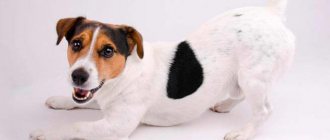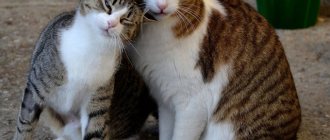Features of behavior and character of British women
When characterizing British cats, you need to understand that everything depends on their behavior. If you want to raise an animal, then you need to do this only up to a year, after which you won’t be able to change anything. Some owners complain about disobedience, not realizing that this is a consequence of poor upbringing . The British are proud enough that they will never ask a person for help. These are not the breeds that will cuddle or purr plaintively, trying to attract attention. These representatives will try to act independently.
While still babies, British kittens easily learn to use the litter box. The aristocratic breed does not allow them to shit wherever they have to. If you look at how a cat sleeps, you can involuntarily smile: on its back, in a ball, with its hind legs outstretched, on its side. The places to sleep are no less fun. Sometimes fluffy hides in places where you wouldn’t even think of looking for him - in a laundry basket or among soft toys. The habits of the British dog are often unpredictable, but this is dictated by the breed and some inherent instincts.
The history of the appearance of true British colors
The main role in the formation of new colors in cats belongs to genetics. The first cats bred without any rules, since the survival of the species was the main goal. But when the cat became a pet and settled next to a person, the situation changed dramatically.
The owners wanted to make some parameters more predictable in order to get kittens with a certain coat color.
The gray-blue shade has been recognized as the main color for British Shorthair cats. The further evolution of colors began with him. The main achievements of the debut period are attributed to the English artist Harrison Weir, a great lover of British cats and a specialist who compiled the first standard of this breed.
During the selection, a line of solid colors was fixed, where, in addition to the main one (often called British), a palette of white, black, blue, cream, chocolate and red appeared. And at the end of the twentieth century, a purple tint was added to them.
Character of British cats
Multifaceted and contradictory - this is how the character of “aristocratic animals” can be briefly described. Representatives of the British differ significantly in disposition from other cat breeds.
They never:
- They won’t sit in the kitchen and yell for food to be poured into them.
- They will not ask to be held by their owner, and will not sit on their laps if you take them by force.
- They won’t rub against their owner for days.
Cats spend all their free time to their advantage and do what they want. The British are independent and proud.
Cleanliness
Cleanliness is something that cannot be taken away from British women . This is inherent in them, this is what their mother cat teaches them. Purrs can lick themselves for hours without getting tired, and until the procedure is completely completed, they will not switch to another activity.
Representatives of this breed will not allow themselves to tear up furniture if they have a nail clipper for this purpose. Having shown the animal a couple of times the place reserved for sharpening nails, they will remember it forever.
Mind
The British are not short on intelligence. Tangles understand everything almost the first time. The only task that lies with the owner is to initially show the animal where to go to the toilet, where is the place to eat, where is the lounger, and the like.
Amenability
The British Shorthair cat gets along well with any animal, be it dogs, cats, parrots, iguanas and other representatives of the “wild world”. If a Briton doesn’t like something, he will not tolerate the disgrace that is happening next to him, but will turn around and proudly leave.
The same applies to children: when kids don’t touch cats, they don’t pay attention to them. Otherwise, the felines get up and go home.
Stubbornness and touchiness
All cats are stubborn in their own way, and the same applies to the British. Speaking about the character of British cats, it would not be out of place to say that they do everything according to their own wishes and at their own discretion. If a furry friend doesn’t want to lick him out of his house to play in the cold season, for example, then you can’t force him to do it. Of course, you can shake the animal out by force, but it will immediately find a place where no one will disturb it.
As for touchiness, pets have plenty of this. If the owner scolded the four-legged animal undeservedly or suddenly raised his hand to it, one should expect trouble. The cat will not forgive this, so it will sit in the shelter for a long time, and then refuse to eat.
Important! To avoid having to scold an adult cat for the slightest misdeeds, kittens should be taught order from childhood, instilling in them certain skills.
Restraint
The character of British cats is such that they do not like to show tenderness, love or resentment towards people, and especially in front of strangers. When an animal is offended, it will lick itself for a long time, thus relieving stress. A joyful bundle can make a circle of honor around a person, and then climb into its house or go to another favorite place. Only some representatives of the British can be gentle and loving, but this is due to the merit of the person who taught the animal to do this from childhood.
Playfulness
A cat's life consists of more than just sleep and food. Games play a big role for felines. The British are big fans of fooling around, of course, within the limits of what is permitted. An exception may be adult cats, although they can sometimes be caught doing this.
Kittens are overly selective in their games. What they like most is hiding and emerging from their ambush. Attacking is another fun activity for them. In this way, they try to imitate adult representatives who, in a playful way, teach their children to attack and also defend themselves. Sometimes, when kittens are tired, they pretend to sleep so that they can be left for a while. And after a short period of time, they pick up, raising their tail, and begin to chase their prey again.
Animals associate some toys with real prey - mice or rats. Swinging objects may remind four-legged birds of birds or butterflies that they so want to catch. At the same time, animals understand perfectly well that when playing, they are not hunting anyone, so they behave somewhat differently. When tracking real prey, the pets are serious and attentive, sometimes the cats are angry, but you can’t do without this when hunting. At home, they rarely release their claws, and their bites do not hurt at all.
Knowing the character of the British, many breeders recommend that owners set up a small corner for their pets, throwing small toys and strings there. If a person does not have time to play with his four-legged pet, then he needs to be given the opportunity to occupy himself independently.
Important! Cats who are not given time and who do not have toys begin to play mischief: jumping on furniture, hanging on curtains, knocking down everything in their path. And this is not the fault of the animals, but of the people who did not provide their pets with everything they needed.
Description of the breed
The blue British shorthair cat is one of the most popular cats in Russia at the moment. It’s very simple to answer the question “why”, just look at the photo: a large body with powerful paws, short fur of an amazing color with a thick undercoat, a regular shaped head with round large eyes of yellow shades, plush cheeks and... a smile!
Yes, it is the special structure of the faces of these aristocratic cats that creates the illusion of a friendly smile, for which they are quite justifiably compared to the Cheshire Cat from the famous Disney cartoon.
It is worth noting that two different breeds should not be confused: the British Shorthair and the Scottish Fold. A blue fold cat has quite a lot in common with a cat of the British breed, and the kittens of these breeds in the photo are very similar, but generalizing them is quite a big misconception.
If you decide to choose a blue British Shorthair kitten, then you should contact well-known nurseries in your city that specialize in breeding this breed. There you can carefully examine the kittens: touch, stroke and observe the behavior of the future pet.
First of all, the kitten must be at least 12 weeks old and have clean, plush fur, skin without damage, and mucous membranes of the eyes without swelling or redness. The animal should be playful and inquisitive; lethargy and apathy are, on the contrary, a bad sign.
- Exhibition kittens are classified as Show - this means that the appearance and character of the cat must ideally correspond to the standards of the breed. Such animals must easily endure travel, large crowds of people, and be able to show themselves and their character at exhibitions without embarrassment or timidity.
- The Breed category includes kittens for which their pedigree is very important, because animals of this class are bred for subsequent breeding. They can also participate in exhibitions, but their main criterion should be the ability to pass on the best breed qualities from generation to generation.
- The Peet category is assigned to the British "domestic type". Such animals may have minor defects or abnormalities, or may be too shy to be shown or posed for photographs. Of course, the presence of defects in this category is not at all necessary, but they do occur. However, the criterion for these animals is ideal adaptability to keeping a home, without losing the basic qualities of the breed.
Of course, the most important thing is that a purebred British Blue kitten must have a veterinary passport with vaccinations and a full description of the pedigree, and its breeder must have a certificate or other document confirming experience in breeding.
Psychology of British cats
The character and behavior of a British cat can be very different. However, the key determining factor is the animal's mood. The owner himself can spoil it or, on the contrary, improve it. Despite the fact that the pet is self-sufficient and can be alone for a long time, it cannot be ignored.
Some owners of four-legged animals complain that with the appearance of a child or another animal in the family, the British change, become closed and touchy. This happens because no one pays attention to the furry friend; they found a replacement for him. The British actually become very attached to their owners, but only because of their disposition do they not show it. However, this does not mean that animals can live on their own; they also want to be handled and noticed.
How to bathe a cat
The British are clean, but they still need to be bathed sometimes. To do this, you must use special tools and follow the following rules:
- the pet should be placed in a basin filled one third with warm water;
- When applying shampoo, you should support the cat under the neck;
- The soap product must be washed completely; a shower and a comb may be useful for this.
After bathing, the animal must be wrapped to dry the fur. When it dries, you can comb it carefully.
Habits
The bright character traits of the British directly influence their habits. Some people believe that since animals belonging to the presented breed are quite obedient, then they cannot do any bad things, but this is not so.
Common negative habits include:
- Scratching and biting hands.
- Throwing objects off surfaces.
To somehow compensate for this, many people want to know how the British are doing with catching mice, and this is a completely different matter.
Catching mice
British cats are often called clumsy. It is impossible to argue with this, but this does not prevent them from being excellent rat-catchers and mouse-catchers. If you believe history, the French always took cats of these breeds with them on voyages so that they would keep an eye on supplies and leave no chance for rodents to profit from various delicacies.
It is rare to find mice in modern apartments, so even with a strong desire, it would be difficult for cats to try to hunt someone. Another thing is animals that live in private sectors and in dachas. Pet owners have repeatedly noted that cats are very agile and excellent hunters. Some people believe that since they managed to cope with the rodent, they should definitely feast on it, but this is not so. Representatives of felines catch mice and rats for fun, they do not even understand that this is food that should be eaten. The reason lies in the character of the British cat, which was taught from childhood to a place for food. Having played enough, the animal leaves its prey and goes on about its business.
Biting and scratching
Scratching and biting the hands of their owners is a favorite activity of four-legged animals. At the age of three or four months, the kitten begins to bite the hands and sometimes the legs of a person. This is directly related to the change of teeth in animals. There is no need to think that such a habit will go away on its own. If the situation continues for a month, the animal will realize that it is possible to do this and in the future you will not wean it from it. At the same time, there is no need to try to beat the baby or shout at him; it is not his fault that his teeth itch. It needs to be done much simpler - during an attack, put a soft toy or mouse on your hand, which will interest the pet and become its favorite victim in the future.
Dropping items
Throwing objects off the table is an equally interesting activity. It can be anything, from a pen to a flower pot. Among the main character traits, self-indulgence is not listed among the British, but for them it is not self-indulgence, but curiosity. Cats are very interested to see how the object will fly down and what will happen to it after. If you want to stop this, then you should either sprinkle the surface with a pungent odor that animals cannot tolerate, or make the surface so that the pet does not have the slightest chance of climbing on it. At the same time, you must not forget about toys for your pet so that he does not have to get bored.
What to feed them
British cats are prone to obesity, which should not be allowed. Excess weight and a sedentary lifestyle will lead to poor health of animals and the development of diseases. You should not accustom them to flour and sweets, give them food from the table and allow them to beg.
The diet may consist of dry food or food prepared by you. When choosing dry food, strictly follow the instructions for choosing the amount of food. Remember, the package indicates the amount of food per day. Choose your own food for each age. The packaging indicates two numbers for the consumption rate in grams.
The first number is the amount of food for sedentary and inactive cats, the second number, on the contrary, is for active cats who walk outside for at least 3 hours. Do not mix dry food with table feeding. The fact is that dry food is made taking into account the correct balance in daily nutrition, with the addition of vitamins, nutrients, etc. If you overfeed your cat, the excess will be deposited in the form of fat on the animal’s ribs or stones will form in the genitourinary system.
When compiling your own diet, determining the daily intake will be somewhat more difficult. When developing a menu, consider the following characteristics of your pet: age, activity level, living conditions and weight. If you have a kitten, you need to feed it 2 times more often and more than a cat over 3 years old. A kitten can be compared to a small child who needs a lot of vitamins and high-calorie food, since a lot of energy is spent on its development and during play. Therefore, nothing is deposited on the ribs.
With an active lifestyle, the animal needs a lot of vitamins and nutrients consumed throughout the day. Also, the daily consumption rate should be higher than usual if the cat does not live at home during the winter, near the radiator, but in an unheated room.
Check your pet regularly for signs of excess weight. First of all, check for the presence of fat on the lower abdomen, between the hind legs. Secondly, feel the ribs. You should start worrying about the problem of obesity if you feel a fatty layer on the ribs. Another way to determine body fat is when the animal's body has acquired a square shape.
To solve the problem of obesity, gradually reduce the amount of food you eat. Cats eating dry food need to reduce the daily intake to 3-4 times over 1-2 weeks. At the same time, monitor its condition and appearance. The main thing is not to overdo it. Go see a veterinarian. He will advise what to feed a British breed cat to treat obesity. In veterinary stores you can buy special low-calorie food for the “diet” period. They will not allow the fat layer to accumulate without reducing the volume of feed given.
When creating your own diet, exclude fatty, sweet, flour products such as semolina, pasta, millet cereals, etc. Include lean beef, vegetables, dairy products and low-calorie cereals such as oatmeal, millet and corn chaff in your diet. The volume of previously consumed food is reduced to 2 times. The ideal option is a combination of diet and exercise.
About activity
The character of British kittens, like cats, can actually be reserved and sometimes even cold, but this does not in any way affect their activity. The British sleep a lot, but in their free time they will do what they want: run, jump, play. The exception in this case is only older representatives of the breed. Pets that have access to the street are more active. They are interested in everything around them: leaves, butterflies, flowers, so cats can spend hours on end outside. If there are several cats in the family, then additional activity will be provided. This is very good, since active animals have much fewer health problems.
Important! To prevent your cat from lying around in the apartment, you should play with him from time to time and offer him some options for useful ways to spend his waking hours.
Attitude towards other animals
If you already have an animal in the house and you decide to get a British one, then it is very difficult to guess how the relationship will develop. Representatives of this breed have a rather capricious character, everything is very individual.
There are no particular problems with other pets. Relationships can be very good if a British kitten and another cat or dog are taken into the house at the same time. They are still getting used to each other as babies.
Material on the topic: what is the British cat breed.
In the case when an adult is taken into the house, everything depends on how the other animal will treat the representative of the British breed. They really don't like being bothered. It doesn’t matter what kind of pet is next to them in the same apartment. The main thing to maintain calm is to simply not bully or touch them.
Britons usually get along easily with other animals.
Do the British have bad habits?
It is believed that aristocrats do not and cannot have bad habits. Of course, the behavior of British cats may sometimes not fit into the generally accepted framework of these peculiar animals, but in any case, representatives of other breeds should be compared to them. This is not entirely true.
There are several bad habits of British cats that you should be aware of:
- Using the owner's personal belongings as toys, as well as items that cannot be used for these purposes. We can talk about jewelry, tubes of creams, sweets. If there is no fear that the animal will take these items somewhere, then you should not take them from him. The kitten will frolic a little and will lose all interest in what was just found. Otherwise, it is better to pick up the item, but be sure to exchange it for any other one.
- Some animals love to climb inside bags, boxes, packages and cabinets. It is difficult to find an explanation for this, but this does not mean that the pet will immediately stop doing this. In this case, you can also do it in two ways - allow it to be done or try to wean it off by replacing one activity with another.
Britons may actually be skittish animals, but they are also very intelligent, playful and active pets.
Did you like the article?
Bad habits
Like any other cats, cats of the British breed have their own bad habits and habits.
Cats love to drop objects. In such a situation, you need to immediately prohibit your four-legged friend from behaving this way. Try treating the surface with something. Rest assured that after the first punishment the Briton will realize his mistake.
Sometimes kittens may start scratching and biting. In adult cats, this habit usually disappears. If it remains, you should buy various pet toys at the pet store with which the kitten can have fun and thereby get rid of the habit.
Some cats love to inspect the contents of many people's bags and packages. They are unlikely to harm things, so you shouldn’t stop this habit.
How many years do cats live?
Representatives of the British breed naturally have fairly good health, due to which they are less susceptible to various ailments, and therefore live longer on average. Another reason for comparative longevity compared to other breeds is that modern representatives of the British have admixtures of other breeds - this has made it possible to ensure genetic diversity and once again protect pets from diseases.
The average life expectancy of Britons is approximately 12-15 years, but this figure is only an estimate. In practice, everything depends on the characteristics of the cat itself, and on how well it was cared for throughout its life.
In particular, if a thoroughbred individual has several centenarians in the pedigree, it is likely that your individual will reach the milestone of 15 years. There are cases where representatives of the breed lived to be 17-19 years old.
Also, stress of any kind is extremely undesirable for an animal.
A common cause of early death of a pet is various injuries, so it is important to monitor where the cat walks
In general, extending the life of a Briton includes five main tasks that the owner must perform with the utmost rigor:
- the animal’s nutrition should be moderate, but at the same time timely, sufficient and balanced;
- a cat is a predator, for the normal state of the body he needs constant movement, without walks he can become depressed;
- There are no diseases in cats that can be treated on the principle of “going away on their own,” especially in healthy Britons - if any bad symptoms appear, you should immediately contact a veterinarian;
- no matter how effective the treatment is, it is better not to get sick at all and not to be treated - for this you need to carry out regular prevention of major ailments, which consists of timely vaccination and some other procedures;
- It is worth making sure that the animal does not encounter any negative phenomena, be it boredom or hostility from household members - all this is stress, which is so dangerous for the animal.
Origin story
Many experts express a lot of unconfirmed versions regarding the origin of the “British”. According to some experts, the breed of this cat was brought to various countries from France several centuries ago. Sailors took cats with them on their ships to protect food and goods from voracious rodents.
The attractive “British” attracted the attention of breeders of exotic breeds back in the 19th century, while Harrison Fair did a lot to ensure that such a breed was constantly developing. In 1871 he was among the first to organize a show for the British Shorthair Cobby cat, distinguished by its blue tint.
And only in 1950 this breed was recognized in America, after which the whole world learned about this cat. The British cat appeared in our country in the last century. Despite this fact, this breed has become popular only recently.
Difference between British Shorthair and Longhair
The British, like girls, are different. And their character depends on the variety.
A breed like this has a very specific and ambiguous character. Depending on your mood, circumstances, your behavior and amount of attention, your pet may behave differently. If you anger an animal, this does not mean that you will be bitten right now. However, he has a good memory. And they will be offended by the owner for a long time
Therefore, it is important not to forget the main rule - the key to the heart of a British Shorthair is love and affection.
But the character is much more flexible than those with short hair. They are like heaven and earth. gets along with people, dogs in the house, will not try to eat your hamster or parrot, and will be friendly with you.
Cleanliness
Each cat approaches its appearance with special responsibility. British Shorthairs will look perfect in any circumstances. Like real aristocrats, they will spend hours getting their paws, antennae and fur in order. Sometimes, self-care for cats of this breed is a great way to relieve stress and bring yourself to psychological calm.
Licking is not just a way for a cat to groom itself. This ritual can be interpreted in different ways:
- Mean support or attention to other animals living in the house;
- A mother cat licks an angry kitten to calm it down;
- Licking is a sign of friendship and trust, that is, a cat will never lick a pet that is unpleasant to it.
Kittens begin to repeat this ritual after adults at 5-6 weeks, maintaining it into adulthood.
Pet health
In winter, a purebred Englishman sleeps with the window open, goes out onto the promenade even in the rain, and hardens himself in the cold. British cats do the same thing, which is why they are famous for their health, and no serious hereditary pathologies have been identified in them.
Although these representatives can suffer from common diseases that are common to all representatives of the cat family. Most often, the British suffer from gingivitis, as a rule, the damage begins with one tooth, and in the process spreads to the entire row. If this is not dealt with, the disease progresses and after a short period of time the cat may lose more than 25% of its teeth.
Another common disease is hypertrophic cardiomyopathy, which is practically impossible to cure. This pathology occurs in adults and is easier to prevent than to cure, so every breeder must know about the symptoms of this disease , it is expressed as follows:
- anorexia;
- lethargy;
- weak heartbeat;
- it is difficult for the cat to breathe, and a characteristic sound is heard when sighing;
- hind leg failure;
- The paw pads take on a bluish tint.
All these signs indicate that the pet has a serious pathology. Experts strongly recommend performing an ultrasound of the animal’s heart.
If you follow all the rules of care, feed your pet correctly and carry out the necessary vaccinations, then the cat can live up to 15 years. There are cases when the animal lived up to 20 years. How long a particular animal will live depends entirely on conditions, heredity and care.











